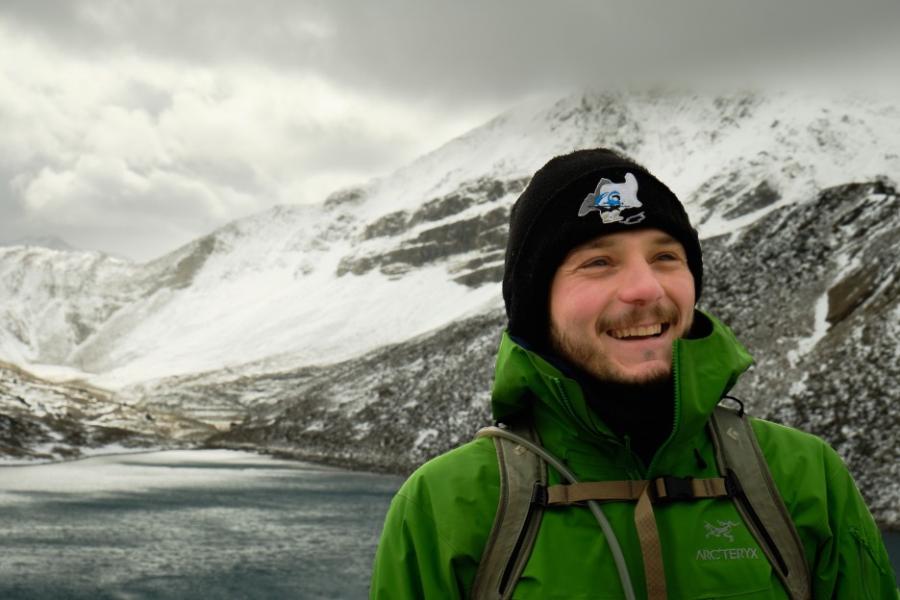Student Research Profile: Luke Storrie
The Department of Environment and Geography is proud to highlight recently published graduate student research.
THE STUDENT
Luke Storrie is a PhD student, in the Department of Environment and Geography, working on the movement ecology of beluga whales. Luke is co-supervised by Lisa Loseto and David Barber and works closely with Nigel Hussey from the University of Windsor. He studied marine biology under an Integrated Master’s in Science at the University of Southampton in the UK for his undergraduate degree, but was able to spend six months in Svalbard and met researchers from the Norwegian Polar Institute, with whom he worked during his Master’s thesis.
Luke is passionate about the natural world and loves learning about it, especially zoology. He says, “scratch the surface and it is full of wonders; ants that farm fungi, fungi that zombifies ants, whales that create nets out of bubbles to aggregate fish, parasitic dwarf male anglerfish whose sole purpose is to latch onto a female and dissolve into nothing but a bag of testes, Greenland sharks which can live for hundreds of years, frogs that survive after being frozen for months. The list is endless. The marine realm in particular has always enthralled me.” Working at the Norwegian Polar Institute in 2014/2015, Luke saw first-hand how things were changing rapidly and knew he wanted to stay in the polar realms for a while. “Every organism on our planet is intricately connected to its environment and to the organisms around it,” Luke adds, “It is only by understanding these interactions that we can identify the roles that organisms play in maintaining biodiverse and healthy ecosystems, and then put effort into helping conserve species and habitats.”
THE RESEARCH
Luke’s paper, Year-Round Dive Characteristics of Male Beluga Whales from the Eastern Beaufort Sea Population Indicate Seasonal Shifts in Foraging Strategies, published in Frontiers in Marine Science, explored the dive behaviour of beluga whales in the Eastern Beaufort Sea. Luke says that “this was the first study to look at fine-scale dive behaviour over the annual cycle and we proposed various dive types were used for foraging, recovering, transiting, and navigating through sea ice. What surprised us was the intensity with which belugas made foraging type dives throughout the year.” This paper provides a critical baseline on beluga behaviour to assess future impacts associated with ongoing shifts in environmental conditions in the Arctic.
The paper highlights the importance of animal movement to understand their behaviour. Luke notes, “movement is ubiquitous throughout the animal kingdom, from coral larvae to vertebrates that migrate thousands of kilometres. By looking at animal movements we can get critical information about their behaviour; such as how much time they spend foraging, whether they are disrupted by human activities, and how far they have to migrate between feeding and breeding areas. By extension, animal movement affects the rest of their ecosystems; when auks and gulls migrate to nest on cliffs in the Arctic during summer, their guano provides essential nutrients that stimulate the growth of plants below; when humpback whales lunge feed it provides a cue to other predators that food is nearby.”
THE PUBLISHING
How did you select the journal to publish in? Frontiers in Marine Science is a good journal that has a Marine Megafauna speciality section. I had read papers from this journal which had looked at dive behaviour in other species. They also allow a high word and figure count; for this paper I felt that the inclusion of several maps and figures with dive profiles were necessary to tell the story clearly.
What did you think of the reviewer comments? It took me a while to mull over the first set of comments as the reviewers’ requested changes that would take some time; however, it didn’t take long for me to realize they were incredibly helpful. Both reviewers were very thorough, and their comments helped us make the paper more broadly applicable. I felt much happier with the shape the paper was in on the resubmission.
How did you find the process overall? This paper has been a lot of fun to work on, but I let myself try and address too many questions in the early stages and ended up having to cut a lot afterwards. It is critical when you start working on a dataset to spend some time really exploring the data; make some plots to visualize key patterns, calculate means by unit time or by some variable, trial some methods you have read up on to see if they are suitable. It is easy at this stage to want to answer hundreds of questions with the data, but after the exploring stage you need to take a step back and have a think about a core and unique research question with 2-3 clear objectives that you could envisage in a single manuscript.
THE TAKE-HOME ADVICE
“It is hard to accept that there isn’t enough time or space to do everything you want with the data, but you might get the chance to work on this question in the future or collaborate on it as a co-author.”
CONTACT
Luke Storrie, PhD Student
Department of Environment and Geography
University of Manitoba
Email: storriel@myumanitoba.ca
THE PAPER
Storrie, L, Hussey, N. E., MacPhee, S. A., O’Corry-Crowe, G., Iacozza, J., Barber, D. G., Nunes, A., Loseto, L. L. (2022). Year-Round Dive Characteristics of Male Beluga Whales From the Eastern Beaufort Sea Population Indicate Seasonal Shifts in Foraging Strategies. Frontiers in Marine Science, 8. https://doi.org/10.3389/fmars.2021.715412
Interview by Katarina Djordjevic

